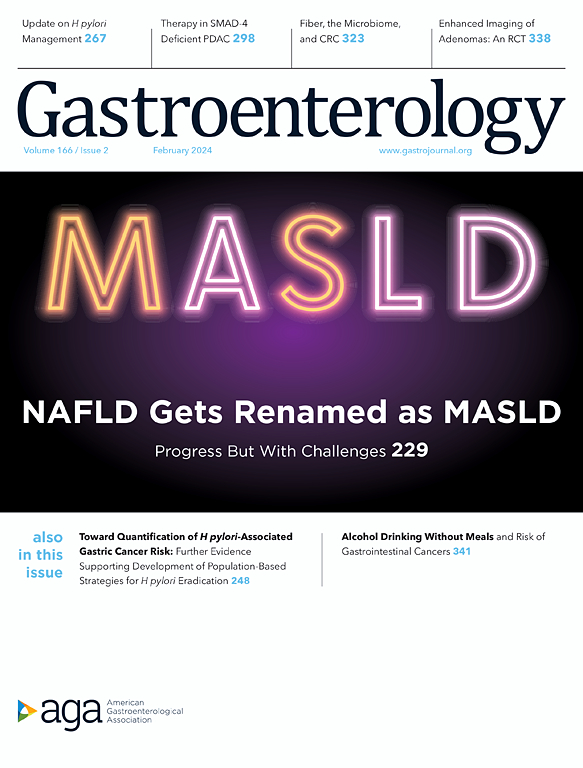Effect of an Endoscopy Screening on Upper Gastrointestinal Cancer Mortality: A Community-based Multicenter Cluster Randomized Clinical Trial
IF 25.7
1区 医学
Q1 GASTROENTEROLOGY & HEPATOLOGY
引用次数: 0
Abstract
Background and Aims
Population-based observational studies suggest that endoscopic screening may reduce upper gastrointestinal cancer mortality. We aimed to quantify the effect of endoscopy screening.Methods
This is a community-based, multicenter, cluster randomized clinical trial conducted in both high-risk and non-high-risk areas of China. Randomization and recruitment occurred between 2015 and 2017, with follow-up conducted until 2022. The intervention was an invitation to receive endoscopic screening, as opposed to receiving usual-care (unscreened). In non-high-risk areas, only participants assessed as high-risk by risk scores in the screening group were invited for endoscopic screening. The primary outcome was the cumulative risk of death from upper gastrointestinal cancer, adjusted for baseline characteristics and cluster effects.Results
A total of 234,635 participants were included in the intention-to-screen analysis, with median age of 52 years. In high-risk areas, 64,836 individuals from 81 clusters were randomized to screening group, 59,379 individuals from 82 clusters were randomized to control group. In non-high-risk areas, 58,367 individuals from 92 clusters were randomized to screening group, 52,053 individuals from 90 clusters were randomized to control group. Among high-risk areas, 480 (adjusted cumulative risk, 0.77%) died of upper gastrointestinal cancers within 7.5 years in screening group vs 545 (0.99%) deaths in control group (risk ratio, 0.78; 95% CI, 0.66-0.91). Among non-high-risk areas, adjusted risk was 0.26% (146 deaths) in screening group and 0.30% (149 deaths) in control group (risk ratio, 0.86; 95% CI, 0.65-1.13).Conclusions
An invitation to endoscopic screening reduced upper gastrointestinal cancer mortality in high-risk areas. In non-high-risk areas, an invitation to endoscopic screening based on risk scores did not significantly decrease upper gastrointestinal cancer deaths, but longer follow-up time was required.

内镜筛查对上消化道肿瘤死亡率的影响:一项基于社区的多中心随机临床试验
背景和目的基于人群的观察性研究表明,内镜筛查可以降低上消化道癌症的死亡率。我们的目的是量化内窥镜筛查的效果。方法本研究是一项基于社区、多中心、聚类随机的临床试验,在中国高危和非高危地区开展。随机化和招募在2015年至2017年间进行,随访至2022年。干预措施是邀请患者接受内窥镜筛查,而不是接受常规护理(未筛查)。在非高风险地区,只有在筛查组中被评估为高风险的参与者被邀请进行内窥镜筛查。主要终点是上消化道癌症的累积死亡风险,根据基线特征和聚类效应进行调整。结果共有234,635名参与者被纳入意向筛查分析,中位年龄为52岁。高危地区81个聚类的64,836人随机分为筛查组,82个聚类的59,379人随机分为对照组。在非高危地区,来自92个聚类的58,367人随机分为筛查组,来自90个聚类的52,053人随机分为对照组。在高危地区,筛查组在7.5年内有480人(调整累积风险,0.77%)死于上消化道癌症,对照组有545人(0.99%)死于上消化道癌症(风险比,0.78;95% ci, 0.66-0.91)。在非高危地区,筛查组调整风险为0.26%(146例死亡),对照组调整风险为0.30%(149例死亡)(风险比0.86;95% ci, 0.65-1.13)。结论邀请内镜筛查降低了高危地区上消化道肿瘤的死亡率。在非高风险地区,邀请患者进行基于风险评分的内镜筛查并没有显著降低上消化道癌症的死亡率,但需要更长的随访时间。
本文章由计算机程序翻译,如有差异,请以英文原文为准。
求助全文
约1分钟内获得全文
求助全文
来源期刊

Gastroenterology
医学-胃肠肝病学
CiteScore
45.60
自引率
2.40%
发文量
4366
审稿时长
26 days
期刊介绍:
Gastroenterology is the most prominent journal in the field of gastrointestinal disease. It is the flagship journal of the American Gastroenterological Association and delivers authoritative coverage of clinical, translational, and basic studies of all aspects of the digestive system, including the liver and pancreas, as well as nutrition.
Some regular features of Gastroenterology include original research studies by leading authorities, comprehensive reviews and perspectives on important topics in adult and pediatric gastroenterology and hepatology. The journal also includes features such as editorials, correspondence, and commentaries, as well as special sections like "Mentoring, Education and Training Corner," "Diversity, Equity and Inclusion in GI," "Gastro Digest," "Gastro Curbside Consult," and "Gastro Grand Rounds."
Gastroenterology also provides digital media materials such as videos and "GI Rapid Reel" animations. It is abstracted and indexed in various databases including Scopus, Biological Abstracts, Current Contents, Embase, Nutrition Abstracts, Chemical Abstracts, Current Awareness in Biological Sciences, PubMed/Medline, and the Science Citation Index.
 求助内容:
求助内容: 应助结果提醒方式:
应助结果提醒方式:


